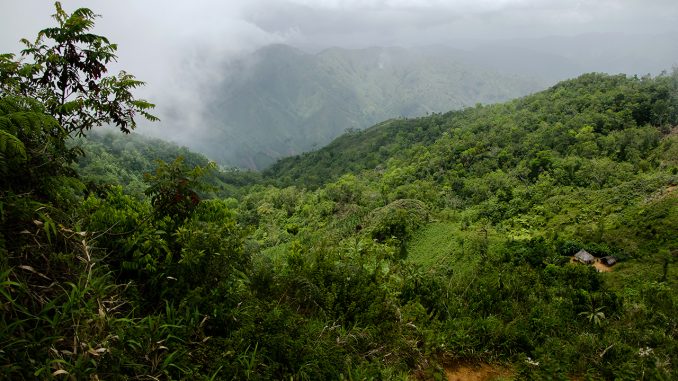
Embarking on helicopter-led expeditions in the Caribbean and discovering previously-believed-extinct frogs are perks Blair Hedges enjoys as a scientist.
But discovering the Morne Grand Bois mountaintop on his first scientific expedition in Haiti in 2009 was something entirely different.
“It was just spectacular,” said Hedges, a Laura H. Carnell professor and the director of Temple’s Center for Biodiversity. “There were forests that were still there that should not have been there.”
This month, Hedges purchased that mountain in Haiti’s Grand Bois National Park on behalf of Haiti National Trust, an organization he co-founded in 2015, to protect the country’s disappearing species and deforestation caused by humans.
He made the more than 1,200-acre purchase in partnership with Société Audobon Haiti, a conservation nonprofit, with donations from the Global Wildlife Conservation and Rainforest Trust.
Since his first trip, Hedges has returned to Haiti multiple times to conduct biological surveys of the country’s forests. The first time Hedges visited Haiti with Philippe Bayard, the president of Société Audobon Haiti, Bayard was impressed by the forests.
“We landed on Grand Bois, and he couldn’t believe the trees,” Hedges said. “[Bayard] said, ‘Blair, I’m going to buy this mountain.’”
Hedges and Bayard founded Haiti National Trust in 2015 to bolster conservation efforts of Haiti’s primary forest, the undisturbed native tree species where natural systems are largely intact.
Hedges published a November 2018 study that found less than one percent of Haiti’s primary forest remains and predicted the country will lose it entirely by 2035. The study attributes the loss primarily to humans cutting down trees.
“Something different was truly needed,” Bayard said in a press release. “We are trying to embark on a new direction for biodiversity conservation in Haiti.”
Fletcher Chmara-Huff, a geography and urban studies professor, said trees are one of the planet’s greatest resources because of the amount of ecology that depends on them.
“If you remove a tree, you’re removing habitat for birds, you’re removing the things that live on the forest floor,” he said. “Changing that then means that you have ripple effects, you have other species that may only be found in one area that can then be negatively impacted through the removal of even a single tree.”
Haiti’s deforestation is especially detrimental to Grand Bois because of the high number of both native and undiscovered species that call the area home, said Joel Timyan, who is the scientific and technical adviser at Société Audobon Haiti and accompanied Hedges on a 2011 Grand Bois expedition as a botanist.
Grand Bois is a “biodiversity hotspot,” housing wildlife like the tiburon stream frog, a rare species previously believed to be extinct that has only been currently found in Grand Bois streams, Timyan said.
The deforestation increases the likelihood of the mountain’s freshwater springs drying up, so it poses a threat to the frog, he added.
“As long as we can keep the Grand Bois forest intact, we believe the springs will continue to flow and this frog will continue to have a suitable habitat,” Timyan said.
Grand Bois became a national park in Haiti in 2015 after Hedges presented research to the Haitian Ministry of Agriculture.
The only problem, Hedges said, was that despite Grand Bois’ new status being legally mandated, Haitian locals still privately owned the land, so they could still cut down the trees.
“It actually had no protective capacity because there were no funding for rangers,” Hedges said. “There were no park rangers, there’s no park cabin, there’s no anything. It’s literally all on paper.”
With the recent purchase of Grand Bois, Haiti National Trust can now legally control the land and make it the country’s first-ever private nature reserve. The group wants to help the Haitian government protect Grand Bois’ biodiversity by paying to employ rangers and build ranger stations and communication towers, Hedges added.
“What we see in Haiti today is probably going to happen in other countries around the world in the near future,” Hedges said. “We’re getting a glimpse of the future of the world, and so it should be an alarm going off in that some bad things are to come unless we work quickly.”


This is a ray of hope at a deeply discouraging time. Thank you!
I am involved with a small organization – Greening Haiti Fund, launched in the last few years, to help the community of Fond des Blancs Haiti re-establish trees, to protect soil and help restore fertility.